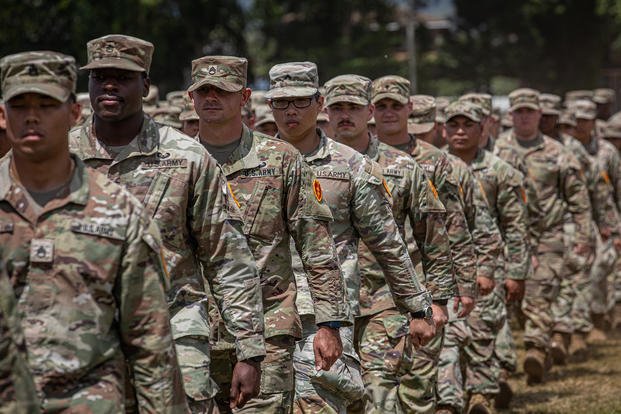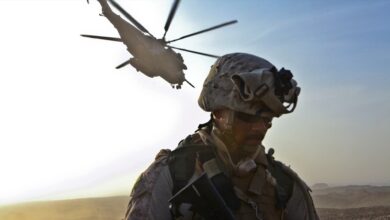Army Soldiers Wrestle with Jungle Challenges in the Pacific


Members of the Schofield Barracks-based 25th Infantry Division are training across the Hawaiian Islands and in the island nation of Palau this month as the Army continues to adjust its operations for the Pacific.
On Wednesday, soldiers from the division kicked off the 2023 rotation for the Hawaii portion of the Joint Pacific Multinational Readiness Center, a series of training ranges in Hawaii, Alaska and around the Pacific.
It’s the third iteration of the training, which certifies Army brigades for deployment.
Historically, this training took place on the mainland at ranges in Louisiana and California.
But as tensions with China shift attention to the Pacific, Army leaders set up JPRMC to keep Pacific-based units in the region, both to save costs on shipping troops in Hawaii and Alaska to the mainland while keeping them in environments that more closely resemble those they’ll be expected to operate in.
It also keeps U.S. service members closer to allied countries and makes it easier for them to send their own troops to participate. This year, allied troops from Thailand, Indonesia, New Zealand and the United Kingdom are also participating, while military observers from several other countries are on hand to watch and take notes.
Col. R.J. Garcia, the 25th’s deputy commander in charge of logistics, said that “what it really does is it allows us to build relationships with our partners, we’re training next to them in these environments, we’re training in the right environments.”
Many of the soldiers leading the exercise are combat-tested troops with years of experience. But most of that experience was in places like Iraq and Afghanistan fighting in drawn-out counterinsurgency campaigns. The Pacific, where the U.S. and China are competing for influence and building up their forces, poses completely new challenges for many of them.
Maj. Jon Azbill, a communications officer with four deployments to Iraq and Afghanistan under his belt, recently arrived in Hawaii and has never trained in the jungle before. He admits the learning curve is steep.
“In the desert there is no interruption, there is no interference from the terrain,” he explained. “Often it’s very flat, the desert is wide open and communication signals travel a long way. So it’s very simple for us to operate. Now, as we kind of shift and pivot to the Pacific, it’s a lot different terrain.”
Thick jungle, high mountains and deep valleys frequently block or disrupt signals and pose problems for troubleshooting. When operating across island chains, the challenges multiply.
Tensions have mounted in the Pacific as China and its neighbors find themselves locked in disputes over territorial and navigation rights in the South China Sea, a critical waterway that a third of all international trade travels through. Beijing considers the entire sea its exclusive territory and has built bases on disputed islands and reefs to assert its claims.
Just south of Taiwan, the Philippines and China have sparred over disputed islands. In 2016 an international court ruled in the Philippines’ favor and declared that Beijing’s territorial claims had “no legal basis.” But the Chinese military has continued to build bases and regularly intimidates Filipino fishermen in the area. This spring, troops from the 25th joined Hawaii-based Marines and members of the Philippine Marine Corps in a series of island landings in the Luzon strait, just south of Taiwan.
“We have not seen a conflict like this since the World War II era,” said Capt. Sam Solliday, an intelligence officer with the 25th Aviation Regiment. “There is an added layer of complexity to the problem set that involves moving assets from different islands crossing wet gaps.”
Maj. Ryan Yamauchi, executive officer for the 25th Infantry Division Artillery, said the exercise is taking into account observations from active conflicts raging around the world, such as the bloody war between Russia and Ukraine. Both artillery and drones have played a central role in that conflict.
Yamauchi said that in Iraq and Afghanistan, American units became accustomed to operating in “static ” positions for weeks, months or even years–usually from large and well-resourced bases. But in Ukraine, where opposing forces have used drones to spot and destroy fighting positions, it’s becoming clear that building up in one place makes forces vulnerable.
Troops now need to be able to reposition quickly. Yamauchi said that in itself is a huge adjustment, but it becomes even harder when dealing with realities of jungle operations.
“The jungle is such a dense environment, [which] is hindering sort of our mobility on ground,” Yamauchi said. He said that has prompted his troops to rely more on aircraft to help them move where they need to go. But that too introduces new challenges.
“The enemy has air defense capabilities that will easily take out these helicopters as they move,” said Yamauchi. “So, obviously, that’s a huge deal with that dense jungle environment.”
The Army has put increased emphasis on logistics in the Pacific and testing its limits. As part of this year’s Hawaii JPRMC rotation, the 25th also sent a rocket artillery unit to Palau aboard an Air Force C-17, where it will practice firing operations as well as use drones to help scan the battlefield.
Garcia said that in sending troops to Palau for the exercise, the 25th is attempting to “simulate really the time distance and decision-making across the Pacific. … What we’re trying to do is simulate what does it take to put combat credible forces forward, and then what do they need to do their mission there?”
(c) 2023 The Honolulu Star-Advertiser
Visit The Honolulu Star-Advertiser at www.staradvertiser.com
Distributed by Tribune Content Agency, LLC.
© Copyright 2023 The Honolulu Star-Advertiser. All rights reserved. This material may not be published, broadcast, rewritten or redistributed.





